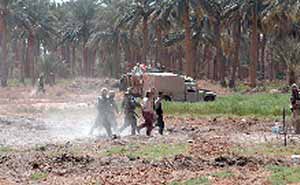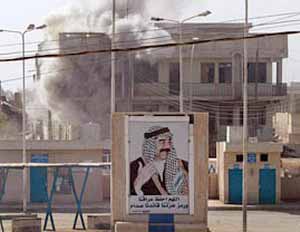The prisoners told the Americans they belonged to the guard's Nebuchadnezzar Brigade, based in Saddam's home area of Tikrit, and they had the guard's triangular insignia. One U.S. soldier was wounded in the leg. An armored unit of the 3rd Infantry Division rolled into the town of 80,000 at dawn and was met quickly by small arms fire and rocket propelled grenades from Iraqis hiding behind hedges and brick walls. On the southeast side of a 200-yard concrete and steel bridge across the dark-green Euphrates, the U.S. soldiers took up positions in abandoned bunkers and sandbags and traded fire with Iraqis on the other side. As the Americans began the cross the bridge, Iraqi troops tried to block it with civilian cars. A dark blue car attempted to race across the bridge toward U.S. forces, but it was hit with heavy machine gun fire, which stopped it in the middle.
Within minutes, 155mm artillery shells whistled overhead, falling along the far side of the river, sending plumes of water into the air. The 3rd Infantry is leading the advance on Baghdad, where a battle looms with the Republican Guard, Iraq's best-trained, best-equipped troops. But it was at Najaf - a city of 300,000, 100 miles south of Baghdad - that U.S. military leaders were faced with a difficult decision. It was unclear whether the U.S. strategy was to take Najaf or simply to cordon off the city. There are too many Iraqi fighters to bypass them or leave them unattended; they are a danger to supply lines on the way to Baghdad. The U.S. Central Command said 100 "terror squad members" were killed Sunday at Najaf and another town in fighting with the 82nd Airborne Division. It did not further identify the "terror squads" or give other details about the captured Iraqis. The 101st Airborne Division surrounded Najaf, preparing for a possible house-to-house battle to root out Saddam's fighters - but leery of damaging some of the faith's most sacred shrines. In Najaf, the prophet Muhammad's son-in-law Ali is buried at an elaborate shrine, its gold dome and twin minarets gleaming for miles. It is surrounded by low buildings and narrow streets, a nightmare of an urban battleground. Other Muslim holy figures are buried there and at the vast Wadi es-Salaam cemetery - one of the world's largest - that forms a semicircle around the city. U.S. officers said some of the Iraqi fighters were hiding there. A battle that destroyed these holy places could inflame Shiites in Iraq and elsewhere, most notably Iran. The United States has been hoping that Shiite Muslims, who represent 60 percent of Iraq's population, will rise up against Saddam and his largely Sunni leadership. Ibrahim Khalili, a prominent Iranian Shiite clergyman, said: "I don't think that anyone dares to attack a holy site in Iraq. An attack on holy shrines will only provoke the uncontrolled anger of Muslims, especially Shiites, with serious consequences to the attackers." Capt. Micah Pharris, an attorney in the 101st Airborne's judge advocate general's office, said some locations in Najaf are on the military's "no target" list - to be fired at only in self-defense. The Army held out hope that the battle could be avoided. Using loudspeakers mounted on Humvees, U.S. soldiers planned to beseech the townspeople of Najaf to turn over Saddam's zealots. Republican Guard positions between Karbala and Baghdad continued to be bombarded by the allies. Gen. Richard Myers, chairman of the Joint Chiefs of Staff, said more than half of Sunday's sorties were directed at the guard. North of Baghdad, meanwhile, U.S.-backed Kurdish troops took control of territory left by withdrawing Iraqi forces. The Kurds advanced almost 10 miles, slowed by hundreds of mines. In the south, British commandos Sunday attacked Iraqis outside the besieged city of Basra. British military spokesman Group Capt. Al Lockwood said that the British destroyed a large number of tanks, seized an enormous amount of equipment and took some 30 Iraqis prisoner. He said casualties were heavy on the Iraqi side, while one British soldier was killed. "There have been some significant military figures captured," he said, but he would not elaborate.
|

